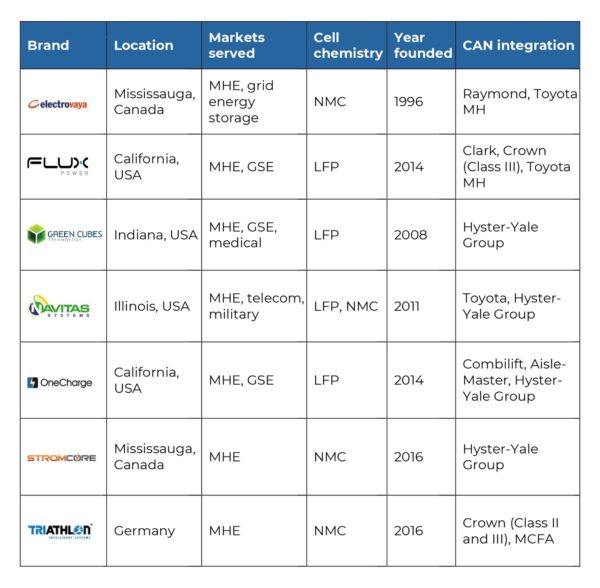 Anton Zhukov
Anton Zhukov Review of the North American Lithium Forklift Battery Market: The Seven most popular brands in the USA and Canada
16600 Aston
Irvine, CA 92606
http://onecharge.biz/
The major factors responsible for the growth of the global lithium market are the increasing number of applications in battery-powered equipment and the need for cleaner energy sources. Increased demand is created by various industries, particularly the electric vehicle/auto industry and the energy storage system industry. Ongoing research and innovations in lithium applications are expected to provide opportunities for further growth. Industrial lithium batteries have been gaining popularity in the USA over the last decade. Lithium power packs are used across many industries including material-handling equipment, defense, and aerospace; at medical, telecom, and data centers; for marine and power storage applications; and in heavy mining and construction equipment.
This review will cover one segment of this big market: batteries for material-handling equipment (MHE) like forklifts, lift trucks, and pallet jacks.
MHE lithium battery market segment
The segment of industrial batteries for MHE includes various types of forklifts and lift trucks, and some adjacent segments, like airport ground support equipment (GSE), industrial cleaning equipment (sweepers and scrubbers), tugs, personnel carriers, etc.
The MHE market segment is very different from other lithium battery applications like automotive, public transportation, and other on- and off-highway EVs.
- Forklifts often have to withstand high vibration due to the widespread use of cushion tires. These demand a more rigid design than pneumatic tires.
- MHE is employed in multi-shift operations spanning 18-20 hours daily, often in extreme ambient temperatures (very hot in some cases and very cold inside coolers and freezers).
- Forklifts rarely leave facilities with easy access to power and charging stations.
- A high level of customization is required for numerous unique forklift types, resulting in a low production volume for each individual battery model.
- The still-low adoption rate of superior lithium technology is the reason why many MHE dealers and maintenance companies do not offer lithium battery service. This is why a battery manufacturer’s own service network is so important in this segment.
Size and growth of the lithium forklift battery market
According to the Industrial Truck Association (ITA), around 65% of lift trucks sold today are electric (the rest are internal combustion engine-powered). In other words, two-thirds of all new material handling equipment is battery-powered.
There is no consensus today as to what share lithium technology has already gained from the incumbent lead-acid technology in the US and Canada. Estimates vary between 7% and 10% of the total number of the new industrial batteries sold, growing from zero in a mere 5-6 years.
The benefits of lithium vs. lead-acid batteries have been tested and proven by major companies across all industries with material handling operations: logistics and 3PL, retail, manufacturing, paper and packaging, metals, lumber, food and beverage, cold storage, medical supplies distribution, you name it. Industry experts are speculating about the growth rate over the next few years (estimated CAGR 27%), but all agree—the adoption of lithium will continue to accelerate, similarly to what we see in the passenger EV market (enabled by similar lithium technology). By 2028, the lithium segment may constitute 48% of all new forklift batteries.
Lead-acid technology still drives forklift engineering
Lead-acid battery technology for electric forklifts is over 100 years old. No wonder electric-powered forklifts were (and still are) built around lead-acid batteries, which determined the format of a power pack and the whole design of a lift truck. Lead-acid technology’s key characteristics are the low voltage (24–48V), high current, and the massive weight of the battery, and in most cases, the latter is used as part of the counterweight to balance the load on the forks.
Market transformation pending
MHE continues to be lead-acid-centric, and that determines the engineering design of the equipment, sales and service channels, and other specifics of the market. However, lithium conversion has started and has already proven its potential to make material handling more efficient and sustainable. With economic and sustainability factors driving the switch to lithium technology, the transformation is already underway. Many original equipment manufacturers (OEMs) including Toyota, HYG, Jungheinrich, and others have launched their first lithium-powered forklifts.
Advantages of lithium forklift batteries
All lithium-ion battery suppliers discuss the advantages of Li-ion batteries vs lead-acid batteries: greater fleet uptime and overall growth in operational efficiency, life cycles that are 2–3 times longer, zero daily maintenance, low lifetime cost, zero pollutants or exhaust, etc.
Several companies offer battery models suitable for a variety of applications, such as work in cold storage areas.
There are two main types of lithium-ion batteries on the market, the key difference being the cathode material: lithium iron phosphate (LiFePO4) and lithium nickel manganese cobalt oxide (NMC). The former are generally less expensive, safer, and more stable, while the latter has a higher energy density per kilo.
Review criteria
This review covers a few basic criteria: company history and product line, number of models and OEM compatibility, product features, service network, and additional information.
A company’s history and product line illustrate its core expertise and the brand’s focus on a specific market segment, or the opposite—a lack of such focus. The number of models is a good proxy for product availability—it tells how likely you are to find a compatible Li-ion battery model for your specific material-handling equipment (and how fast a given company is developing new models). CAN integration of a battery with both a host lift truck and a charger is essential for a plug-and-play approach, an important requirement in many applications. Some brands are not fully transparent yet on their CAN protocol. Product features and additional information describe the differences and commonalities of the battery brands.
Our review does not include “integrated” lithium battery brands, which are sold together with the lift truck. Buyers of these products cannot choose a battery capacity, regardless of their specific application.
We did not include some of the imported Asian brands, as they have not yet built a significant customer base in the US market. Although they offer very attractive prices, they fall short of expectations on very important criteria: maintenance, support, and service. The lack of industry integration with OEM manufacturers, dealers, and service centers prevents these brands from becoming a viable solution for serious buyers, though they can indeed be a good option for small or temporary operations.
All Li-ion batteries are created sealed, clean, and safe. This is especially important when handling foodstuff, medicines, and electronics. However, choosing a Li-ion battery can be quite complicated. You can read more on How to Choose the Right Forklift Battery on the Selector page of the OneCharge website.
Top seven forklift battery brands in America pioneering the transformation of MHE
This review covers a few of the most prominent brands in the USA and Canada competing for the growing share of lithium forklift batteries in North and South America. These are the seven Li-ion forklift battery brands that are driving the adoption of lithium technology by customers and forklift manufacturers (OEMs).
- Electrovaya
- Flux Power
- Green Cubes
- Navitas
- OneCharge
- Stromcore
- Triathlon

Read the full text of Review of Lithium Forklift Battery Brands at https://www.onecharge.biz/blog/
About the Author:









